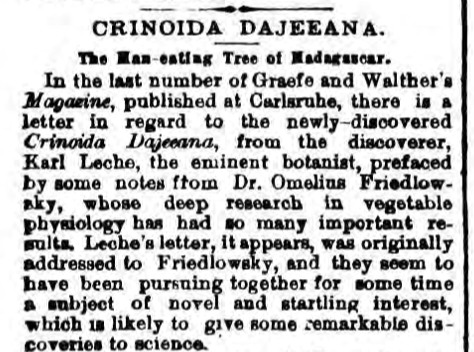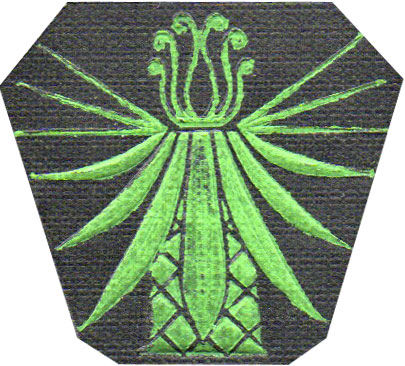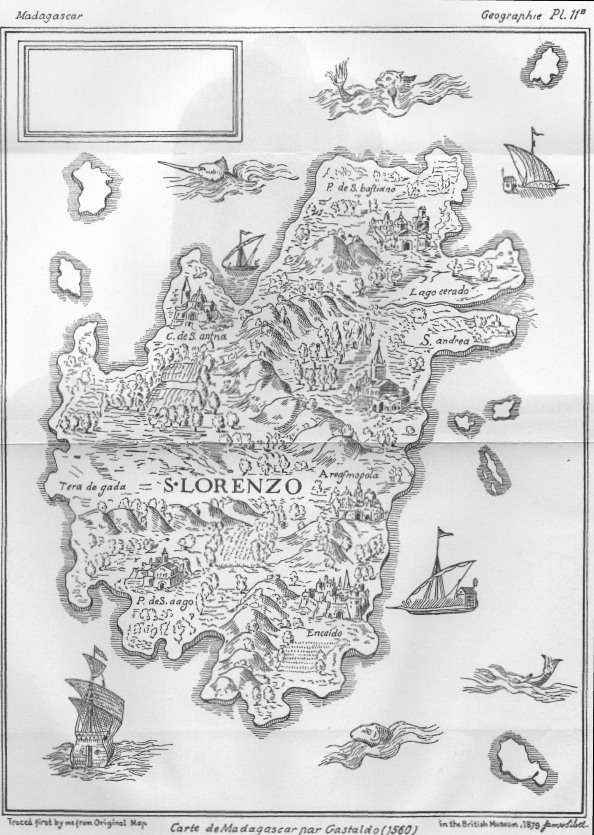It looks like you're using an Ad Blocker.
Please white-list or disable AboveTopSecret.com in your ad-blocking tool.
Thank you.
Some features of ATS will be disabled while you continue to use an ad-blocker.
5
share:
This is one of my favourites....

A artists impression of the deadly plant from a book written about the plant and the tribe that worships it, the Mkodos, small men who feed humans to their god plant


The writer then describes
She does and falls into the plant which appears to react like a venus fly trap
Leche then stated that he studied the carnivorous tree for some time, during which time he found several others. He saw one of the trees eat a lemur. He named the species Crinoida Dajeeana,
You can get the rest of the story at this link
The man eating tree

On April 28, 1874, the New York World ran an article announcing the discovery in Madagascar of a remarkable new species of plant: a man-eating tree. The article included a gruesome description of a woman fed to the plant by members of the Mkodos tribe.
A artists impression of the deadly plant from a book written about the plant and the tribe that worships it, the Mkodos, small men who feed humans to their god plant

In the letter, Leche described how while traveling through Madagascar he came into a region of the country occupied by the Mkodos, "a tribe of inhospitable savages of whom little was known."

If you can imagine a pineapple eight feet high and thick in proportion resting upon its base and denuded of leaves, you will have a good idea of the trunk of the tree, which, however, was not the color of an anana, but a dark, dingy brown, and apparently hard as iron. From the apex of this truncated cone (at least two feet in diameter) eight leaves hung sheer to the ground, like doors swung back on their hinges. These leaves, which were joined to the top of the tree at regular intervals, were about eleven or twelve feet long and shaped very much like the leaves of the American aguave, or century plant. They were two feet through in their thickest part and three feet wide, tapering to a sharp point that looked like a cow's horn, very convex on the outer (but now under) surface, and on the inner (now upper) surface slightly concave. .
The writer then describes
The Mkodos, when they saw the tree, began shouting, "Tepe! Tepe!" Then they surrounded one of their women and forced her, at javelin point, to climb the tree until she reached the apex of the cone that contained the treacly fluid. "Tsik! tsik!" the Mkodos men cried, which meant "drink! drink!"
She does and falls into the plant which appears to react like a venus fly trap
The contraction of the tendrils caused the fluid of the tree to stream down its trunk, mingling with the "blood and oozing viscera of the victim."
The Mkodos rushed forward to drink this mixture of blood and tree fluid. Then ensued "a grotesque and indescribably hideous orgie."
Leche then stated that he studied the carnivorous tree for some time, during which time he found several others. He saw one of the trees eat a lemur. He named the species Crinoida Dajeeana,
You can get the rest of the story at this link
The man eating tree
edit on 26/6/12 by Hanslune
because: (no reason given)
Originally posted by Hanslune
This is one of my favourites....
On April 28, 1874, the New York World ran an article announcing the discovery in Madagascar of a remarkable new species of plant: a man-eating tree. The article included a gruesome description of a woman fed to the plant by members of the Mkodos tribe.
A artists impression of the deadly plant from a book written about the plant and the tribe that worships it, the Mkodos, small men who feed humans to their god plant
In the letter, Leche described how while traveling through Madagascar he came into a region of the country occupied by the Mkodos, "a tribe of inhospitable savages of whom little was known."
If you can imagine a pineapple eight feet high and thick in proportion resting upon its base and denuded of leaves, you will have a good idea of the trunk of the tree, which, however, was not the color of an anana, but a dark, dingy brown, and apparently hard as iron. From the apex of this truncated cone (at least two feet in diameter) eight leaves hung sheer to the ground, like doors swung back on their hinges. These leaves, which were joined to the top of the tree at regular intervals, were about eleven or twelve feet long and shaped very much like the leaves of the American aguave, or century plant. They were two feet through in their thickest part and three feet wide, tapering to a sharp point that looked like a cow's horn, very convex on the outer (but now under) surface, and on the inner (now upper) surface slightly concave. .
The writer then describes
The Mkodos, when they saw the tree, began shouting, "Tepe! Tepe!" Then they surrounded one of their women and forced her, at javelin point, to climb the tree until she reached the apex of the cone that contained the treacly fluid. "Tsik! tsik!" the Mkodos men cried, which meant "drink! drink!"
She does and falls into the plant which appears to react like a venus fly trap
The contraction of the tendrils caused the fluid of the tree to stream down its trunk, mingling with the "blood and oozing viscera of the victim."
The Mkodos rushed forward to drink this mixture of blood and tree fluid. Then ensued "a grotesque and indescribably hideous orgie."
Leche then stated that he studied the carnivorous tree for some time, during which time he found several others. He saw one of the trees eat a lemur. He named the species Crinoida Dajeeana,
You can get the rest of the story at this link
The man eating treeedit on 26/6/12 by Hanslune because: (no reason given)
And the second paragraph in the article reads:
But despite having been debunked, the story of the man-eating tree refused to die. In fact, it became one of the most enduring hoaxes of the 19th Century, continuing to circulate as fact for decades afterwards. During the 20th Century, several explorers even searched for the man-eating tree in Madagascar. Meanwhile, the identity of the author of the story was completely forgotten and was only recovered when the Current Literature journal was scanned and made available online during the 21st Century.
Almost every detail in the story was fictitious. None of the people who were mentioned in it existed — not Karl Leche, Dr. Omelius Friedlowsky, or Dr. Bhawoo Dajee. Nor were the Mkodos a real tribe. The tree itself, most significantly, was pure fantasy — a gothic horror of the colonial era.
As well as the site it comes from being museum of hoaxes.
So was the intention to post a HOAX story or just something that you found funny? Either way it has already been proven HOAX'd apparently.
edit on 6/26/12 by Vasa Croe because: (no reason given)
edit on 6/26/12 by Vasa Croe because: (no reason
given)
Its posted on a site witch points out hoaxes.
Sounds like a fairy tail story.
This is in the wrong section. It should be in the hoax section.
Sounds like a fairy tail story.
This is in the wrong section. It should be in the hoax section.
edit on 26-6-2012 by Infi8nity because: (no reason given)
Originally posted by chiefsmom
Well that sucked! I was hoping it was real.
LOlOLOL
I've done this too. Nice to see someone else goof.
S for the laugh
The OP shouldn't despair for having posted a bummer-story, as the cultural rumours of various large and extreme types of carnivorous plants,
nonetheless do indeed exist. such as, for instance, the The Ya-te-veo, that is described as following;
en.wikipedia.org...-te-veo
In J. W. Buel's Land and Sea (1887), the Ya-te-veo ("Now-I-see-you") plant is said to catch and consume large insects, but also attempts to consume humans. It is said to be a carnivorous plant that grows in parts of Central and South America with cousins in Africa and on the shores of the Indian Ocean.[citation needed] There are many different descriptions of the plant, but most reports say it has a short, thick trunk and long tendrils of some sort which are used to catch prey.
en.wikipedia.org...-te-veo
edit on 26-6-2012 by Nightchild because: (no reason given)
A artists impression of the deadly plant from a book written about the plant and the tribe that worships it, the Mkodos, small men who feed humans to
their god plant
^^^this, among other tidbits seem to have been added in by the original poster, which, in my mind, leads me to believe that perhaps the op thought it to be real? But who knows... It did come from the museum of hoaxes after all. At first I thought the op was playing off the mythology aspect of the Ancient Civilizations forum, but, this wouldn't be a myth of any "ancient" civilizations, as the tribe itself never existed, and the 1800s, the time when the hoax was most prevalent, is hardly "ancient". So, I am just as confused as the rest of you...
Thanks to the op for sharing this interesting story, however ambivalent your intentions may be at this moment.
^^^this, among other tidbits seem to have been added in by the original poster, which, in my mind, leads me to believe that perhaps the op thought it to be real? But who knows... It did come from the museum of hoaxes after all. At first I thought the op was playing off the mythology aspect of the Ancient Civilizations forum, but, this wouldn't be a myth of any "ancient" civilizations, as the tribe itself never existed, and the 1800s, the time when the hoax was most prevalent, is hardly "ancient". So, I am just as confused as the rest of you...
Thanks to the op for sharing this interesting story, however ambivalent your intentions may be at this moment.
Awesome.
...I'm gonna grow one, and feed it bill collectors.
...damnit, I cant grow a hoax plant
...I'm gonna grow one, and feed it bill collectors.
...damnit, I cant grow a hoax plant
edit on 26-6-2012 by becomingaware because: (no reason given)
It been a while since this was discussed and each thread has different sources so I'm leaving the thread open but putting this here for a
cross-reference:
www.abovetopsecret.com...
www.abovetopsecret.com...
In particular, ravenshaow13's which speculates on the source of the crypto tree
www.abovetopsecret.com...
www.abovetopsecret.com...
www.abovetopsecret.com...
In particular, ravenshaow13's which speculates on the source of the crypto tree
www.abovetopsecret.com...
edit on 6/26/2012 by kosmicjack because: (no reason given)
double post. ..sucketh.
edit on 26-6-2012 by becomingaware because: (no reason given)
Yes it is unfortunately a false story, the reason I put this one up is to show how newspaper article that sound authentic or authoriative are just
fake, just noise in the background. Sometime people want to believe so hard they forget that people do do this type of fakery. At that same site they
noted that the author Edgar A Poe faked a number of articles on fantastic subjects.
reply to post by Hanslune
It reminds me of Englebert Kaempfer's investigation of the Borometz Fruit, which according to Botanist Jean Bauhin came from a plant that grew in Tartaria, the fruit of which were 'in the shape of a lamb to a height of three feet'.
The exceptionally fine skin of this fruit it seems was highly prized for hats. Kaempfer revealed that the lamb-like fruit was actually prematurely birthed lamb. Funnily enough.
Marketing ploys for the purpose of keeping the rare and exotic, rare and exotic.
It reminds me of Englebert Kaempfer's investigation of the Borometz Fruit, which according to Botanist Jean Bauhin came from a plant that grew in Tartaria, the fruit of which were 'in the shape of a lamb to a height of three feet'.
The exceptionally fine skin of this fruit it seems was highly prized for hats. Kaempfer revealed that the lamb-like fruit was actually prematurely birthed lamb. Funnily enough.
Marketing ploys for the purpose of keeping the rare and exotic, rare and exotic.
new topics
-
How To Spot Fake U.F.O. Photos
Aliens and UFOs: 8 hours ago -
Scary video of face in an abandoned house
Paranormal Studies: 10 hours ago
top topics
-
LA Mayor Bass Demanded $49M in Additional LAFD Cuts One Week Before Wildfires
Mainstream News: 14 hours ago, 17 flags -
Just Came Across These Unusual Old UFO Pics
Aliens and UFOs: 12 hours ago, 7 flags -
Scary video of face in an abandoned house
Paranormal Studies: 10 hours ago, 5 flags -
How To Spot Fake U.F.O. Photos
Aliens and UFOs: 8 hours ago, 4 flags -
Carry On!
Short Stories: 16 hours ago, 3 flags -
Sepultura - Territory - With New Drummer Greyson Nekrutman
Music: 15 hours ago, 2 flags
active topics
-
Trump says ownership of Greenland 'is an absolute necessity'
Other Current Events • 164 • : Flyingclaydisk -
Fire insurance in LA withdrawn months ago
General Conspiracies • 39 • : Flyingclaydisk -
Los Angeles brush fires latest: 2 blazes threaten structures, prompt evacuations
Mainstream News • 395 • : Flyingclaydisk -
Archbisop Vigano Warns of Deep State and Deep Church
New World Order • 12 • : FlyersFan -
This should be plastered all over the airwaves
Mainstream News • 56 • : Flyingclaydisk -
Oh, Good Gosh. “Kremlin Warns Stay Away from Greenland.”
World War Three • 33 • : Dalamax -
How To Spot Fake U.F.O. Photos
Aliens and UFOs • 4 • : SteamyAmerican -
Just Came Across These Unusual Old UFO Pics
Aliens and UFOs • 6 • : NoCorruptionAllowed -
Trump's idea to make Canada the 51st US state: 'Potential is massive'
Mainstream News • 158 • : charlyv -
Dr. Demento
Music • 17 • : KrustyKrab
5
